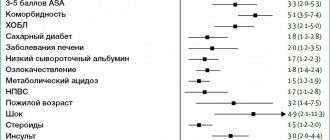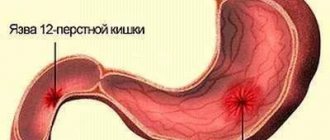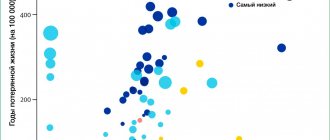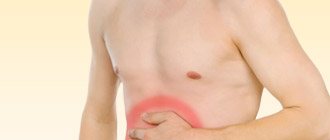Attention!
The information in the article is for reference only and cannot be used for self-diagnosis or self-medication. If you notice any symptoms of the disease, contact your doctor.
Gastric and duodenal ulcer (gastric ulcer) ICD code - K25.3 This name means a limited defect in the mucous membrane of the inner layer of the stomach. Occasionally, the lesion involves the submucosal layer. An ulcer is formed under the influence of pepsin, hydrochloric acid, and bile.
These substances, acting in a limited area, cause trophic disorders. The secretion of hydrochloric acid from the gastric mucosa usually does not increase. A relapsing course is typical for peptic ulcer disease. Characterized by alternating periods of exacerbations that develop in spring and autumn, as well as periods of remission.
An ulcer differs from a superficial lesion of the mucous membrane, called erosion, in that it forms a rough scar when healing. Peptic ulcer disease is considered a fairly common disease. It is detected in approximately 4% of the world's population.
Symptoms of a stomach ulcer
The pain syndrome with a stomach ulcer, in contrast to ulcerative lesions of the duodenum, is more intense. Pain from a stomach ulcer occurs and intensifies immediately after eating. It occurs in the upper half of the abdomen. Most often, the pain is localized in the epigastric zone, occasionally radiating to the left hypochondrium.
The patient associates its appearance with food consumption. Usually the pain starts half an hour or an hour after he eats and stops after two hours. This is explained by gastric emptying. Pain occurs with an ulcer due to irritation of the surface of the defect with food. It stops when taking antacids. In addition, the patient is also worried about other symptoms of a stomach ulcer:
- Heartburn. It occurs when gastric contents, which have an acidic environment, reflux into the lower esophagus. It occurs synchronously with the appearance of epigastric pain.
- Nausea and vomiting. They occur at the same time the pain begins. Vomiting relieves the patient.
- Flatulence. The patient experiences bloating and heaviness of the intestines due to insufficient processing of food with enzymes.
- Signs of high acidity. The patient experiences sour belching and constipation.
A patient with an acute ulcer experiences a sharp decrease in body weight. This is due to the fear of eating, which precedes the onset of pain.
Causes of stomach ulcers
There are two main reasons for the development of stomach ulcers:
- Helicobacter pylori. This bacterium, in favorable conditions for life, destroys the mucous membrane of the stomach and duodenum. It inactivates local protective factors. This cause predominantly causes a mucosal defect. Patients become infected through contact and household contact when dishes and other household items are contaminated with the saliva of an infected person and they are poorly handled. To prevent contracting this infection, it is recommended to wash your hands and use only clean utensils.
- Increased acidity of gastric juice. This pathological condition appears with increased secretion of hydrochloric acid. It eats away the stomach lining. Subsequently, a defect is formed.
About 60% of people are infected with Helicobacter, but not everyone suffers from stomach ulcers. The onset of the disease is associated with the action of predisposing factors. These include the following:
- psychoemotional stress, leading to increased production of hydrochloric acid;
- hereditary predisposition to the formation of gastric ulcers;
- bad habits - smoking, alcohol abuse, coffee stimulate the production of gastric juice;
- chronic gastritis - with a prolonged inflammatory process, ulcers form more easily on the mucous membrane;
- violation of the diet with long breaks between meals;
- consumption of spicy foods, as well as abuse of sour, rough foods contributes to the formation of defects in the mucous membrane.
A long course of certain medications also causes destruction of the inner lining of the stomach (non-steroidal anti-inflammatory drugs, glucocorticoids and others).
Types of stomach ulcers
There are several types of stomach and duodenal ulcers. These include the following varieties:
- Perforated. With this type, a through hole appears in the wall of the organ. A communication is formed between the stomach and the abdominal cavity. Remains of food mixed with acid enter the abdominal cavity. They provoke inflammation in these tissues.
- Stressful. The main reason for its development is activation of the hypothalamus. The body produces adrenocorticotropic hormone. It helps reduce the production of mucus in the stomach and reduce its quality. These substances block the restoration of the mucosa and cause an increase in histamine levels. They provoke a deterioration in the blood supply to the mucous membrane. The acid-peptic balance is disrupted due to increased influence of the vagus nerve.
- Antral. They are detected in young people. It occurs in the stomach at the border with the duodenum. It is manifested by frequent vomiting with a sour taste, heartburn, paroxysmal pain, heaviness in the abdomen.
- Cardiac. This disease is rarely detected in patients. It causes pain after eating. Worries about a bitter taste in the mouth, frequent belching, a feeling of heaviness in the stomach when the stomach is empty. With this pathology, plaque appears on the tongue, as well as left-sided pleurisy. Most often it is detected in men. Severe forms of the disease are treated only surgically.
- Medicinal. The formation appears during treatment with certain drugs - corticosteroids, salicylates, anti-inflammatory drugs. With long-term use of these medications, ulcers and erosions form. These ulcers cause bleeding and severe pain.
- Chronic. This type of disease occurs with a slow, long-term course. This form is registered in a third of ulcer patients. Its main symptoms include severe heartburn, dyspeptic disorders, nausea and vomiting after eating, heaviness, and severe pain. Seasonal exacerbations are typical for the disease.
- Calleznaya. It often degenerates into stomach cancer and is localized on the lesser curvature. It is open for a long time, there are no signs of scarring. Arises from a chronic ulcer. Its main manifestations are severe pain, nausea and vomiting. It is treated primarily through surgery.
- Peptic. It is located on the lower part of the stomach. Occurs as a postoperative complication. The main role in the formation of the defect is played by Helicobacter infection and treatment with certain drugs. The main symptoms are intense pain that occurs on an empty stomach, nausea, vomiting with blood clots, diarrhea with blood, weight loss, loss of appetite.
- Mirror. The defect forms at the site of existing inflammation, most often in the lower part of the stomach. It deepens under the influence of gastric juice. It captures several layers of the stomach wall at once. With this form, severe pain does not stop for a long time. These injuries are difficult to heal.
- Endocrine. It is formed when there is a sharp increase in gastric secretion, which occurs due to an increased level of gastritis. The lesion has symptoms typical of an ulcer. The defeat appears suddenly and acutely. Difficult to respond to all types of treatment.
Often ulcerative lesions occur against the background of other somatic diseases: cirrhosis, renal failure, hepatitis, pathologies of the pancreas, as well as the cardiovascular system.
Definition and characteristics of the disease
Worldwide, ulcer perforation is considered one of the most dangerous conditions in emergency surgery with a high mortality rate.
Perforation is the formation of a hole in the wall of the stomach that opens into the abdominal cavity. Mostly (up to 85%) a perforated ulcer develops against the background of increased inflammatory-destructive processes in the focus of a chronic or acute ulcer. And in 20%, perforation is observed in people without previously observed symptoms of peptic ulcer.
Complications of stomach ulcers
Bleeding is the most common complication. If a vessel inside the ulcer is damaged, the patient does not feel anything at first. The stomach fills with blood, then vomiting occurs. All bleeding is manifested by signs of blood loss: blood pressure drops, the skin turns pale, severe weakness and shortness of breath bother.
When bleeding from an ulcer located in the duodenum, dark stool appears. In addition to bleeding, other complications of this disease occur:
- Perforation. Appears when all layers of the gastric wall of the stomach are destroyed, and then through perforation. This requires mandatory surgical intervention.
- Penetration. This is the growth of an ulcer through the wall of the stomach into nearby organs. The pancreas is most often affected; liver damage is less common. The symptoms of an ulcer are accompanied by manifestations of acute pancreatitis.
- Stenosis of the gastric outlet. It appears when the ulcer is localized in this area. Food does not pass from the stomach to the intestines. For treatment, surgical intervention is performed to restore the patency of the organ.
- Perigastritis. Inflammation forms around the ulcer. Then, adhesions with other organs form on the outside of the stomach. This leads to deformation of the stomach.
- Malignization. A malignant tumor forms at the site of the ulcer. This complication occurs rarely. It is dangerous to the patient's life.
If there is a sudden change in the symptoms of an ulcer, you should immediately consult a doctor, as many complications threaten the patient’s life.
Mechanism of disease development
Exacerbation of the chronic destructive process in ulcer tissues without signs of regeneration leads to gradual damage to all layers of the gastric wall. At the bottom of the ulcer, new foci of necrosis appear, the size of the ulcerative defect increases in depth and width, which causes the formation of a through opening in the wall of the organ.
From the resulting hole, gastric juice flows into the free abdominal cavity. All organs of the abdominal cavity are covered with a special protective membrane - the peritoneum. Gastric secretions have physical, chemical, and later bacterial effects on the peritoneum. The body reacts to perforation with a state of shock as a result of a burn of the serous membrane by acidic gastric juice. Then comes the stage of serous-fibrous peritonitis with the transition to diffuse purulent or local peritonitis.
Sometimes perforation of an ulcer occurs unexpectedly against the background of health in young people without connection with a gastric ulcer. This is explained by the development of autoimmune processes in the body, when produced antibodies show aggression towards its own cells.
At the lesion site, an inflammatory response is activated with the release of a large number of inflammatory mediators (serotonin, prostaglandins). The aggressive acidic environment of the gastric chyme contributes to the destruction of the gastric wall, which leads to the appearance of a hole.
It is still not possible to fully elucidate the mechanisms of ulcer perforation.
Diagnosis of stomach ulcers
When diagnosing a peptic ulcer, the patient's history and complaints are carefully collected. During a physical examination, the abdomen is palpated, revealing tension in the anterior abdominal wall in the epigastric region. To identify lesions, the following methods of examining the gastrointestinal tract are used:
- blood test to determine antibodies to Helicobacter Pylori;
- pH-metry of gastric juice;
- X-ray examination of the stomach;
- fibrogastroduodenoscopy.
Diagnosis is carried out using microscopy of a biopsy taken from the affected area of the gastric mucosa. To do this, gastroscopy is performed. The biopsy is taken during endoscopic examination and examined to determine Helicobacter Pylori.
Types of perforated ulcers
In addition to cases of typical perforation into the abdominal cavity, which account for 80-90%, there are other variants of perforation.
Covered perforation is observed in 5–8% of cases, when the hole in the stomach is closed by the wall of an adjacent adjacent organ, part of the omentum, fibrin film or a piece of food bolus. The clinical picture has a two-phase course: an acute onset, as in a typical case, then the extinction of symptoms, as the opening closes and gastric juice no longer exits into the abdominal cavity.
Atypical perforation (0.5%) occurs when gastric secretions spill into a closed area limited by fibrous adhesions.
Combined option . In 10% of all cases of perforated ulcers, a combination of perforation and internal bleeding occurs. This significantly changes the symptoms, which leads to late diagnosis and unfavorable outcome of the disease.
Treatment of stomach ulcers
Drug therapy for gastric and duodenal ulcers must be combined with diet. Gastroenterologists, therapists and surgeons should treat the patient. The doctor selects the individually required groups of drugs for each patient, as they have their own characteristics.
Treatment regimens
Treatment for gastric and duodenal ulcers depends on the severity of the disease and examination results. Treatment is prescribed, which includes three or four medications from two groups. Helicobacter Pylori is destroyed using antibiotic therapy.
In case of complications (perforation, perforation, stenosis) and severe cases, patients undergo surgical treatment, since it cannot be cured with medication. To do this, he is hospitalized in the surgery department.
Diet
Diet therapy is a mandatory treatment for gastric and duodenal ulcers. A special diet for ulcers is prescribed to each patient. Be sure to exclude alcohol and strong coffee. It is forbidden for a person to eat or drink anything hot. A change in your usual diet is necessary. Eat only foods that are gentle to the gastric mucosa. It should not increase the secretion of gastric juice.
For the diet, coarse, cold, hot, spicy, bitter foods are excluded from the diet. Fatty, fried and salty foods are prohibited. The use of canned food and sausages is not recommended. Foods that increase appetite should also be excluded.
Food should be warm. It is served in liquid or pureed form. It is healthy to eat boiled or steamed foods. Here's what you can eat: slimy soups, porridges, purees, steamed cutlets and the like. Outside of an exacerbation, the diet can be slightly expanded. The patient should eat small meals up to 5 times a day. The daily caloric intake for the diet is reduced to 2 thousand kcal per day.
Treatment with folk remedies
Folk remedies are actively used as part of complex therapy. They do not replace primary treatment. Before using these medications, you should definitely consult your doctor.







